Actron CP9185 User Manual
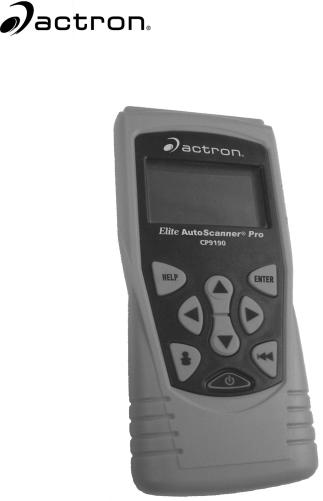
CP9185
CP9190
Elite AutoScanner®
Elite AutoScanner® Pro
P/N 0002-001-2933

Scan Tool Information
Complete the following list using the function “Tool Information”. Provide this information when contacting customer support.
Serial No:
SW ID:
HW Ver:
Boot Ver:
Prod ID:
Board ID:
Burn Date:
Burn Loc:
If you have questions or concerns Contact
Technical Support:
•Phone: 1-800-228-7667 •Website: www.actron.com
•Mail:SPX Service Solutions
•15825 Industrial Parkway
•Cleveland, Ohio 44135
•Attn: Technical Support
Copyright Information
Copyright © 2006-2007 SPX Corporation
All rights reserved.
The information, specifications and illustrations in this guide are based on the latest information available at the time of printing. SPX Corporation reserves the right to make changes at any time without notice.

Table of Contents
Safety Precautions
ToC |
Important Safety Messages . . . . . . . . . . . . . . . . . . . . . . . . . . . . . . . Safety - iii
Section 1 – Using This Manual
Section 2 – Getting Started
Introduction . . . . . . . . . . . . . . . . . . . . . . . . . . . . . . . . . . . . . . . . . . . . . . . . . 2-1 Using the CD . . . . . . . . . . . . . . . . . . . . . . . . . . . . . . . . . . . . . . . . . . . . . . . . 2-2
Installing Applications On Included CD . . . . . . . . . . . . . . . . . . . . . . . . .. 2-3
Vehicle Service Information . . . . . . . . . . . . . . . . . . . . . . . . . . . . . . . . . . . . 2-4 Introduction to On-Board Diagnostics . . . . . . . . . . . . . . . . . . . . . . . . . . . . 2-6
SAE Publications . . . . . . . . . . . . . . . . . . . . . . . . . . . . . . . . . . . . . . . . . .. 2-7
Data Link Connector (DLC) . . . . . . . . . . . . . . . . . . . . . . . . . . . . . . . . . . . . . 2-9
OBD II (J1962) . . . . . . . . . . . . . . . . . . . . . . . . . . . . . . . . . . . . . . . . . . . .. 2-9 Ford Historic . . . . . . . . . . . . . . . . . . . . . . . . . . . . . . . . . . . . . . . . . . . .. 2-10 GM Historic . . . . . . . . . . . . . . . . . . . . . . . . . . . . . . . . . . . . . . . . . . . . .. 2-13 Chrysler Historic . . . . . . . . . . . . . . . . . . . . . . . . . . . . . . . . . . . . . . . . .. 2-14
OBD II Diagnostic Trouble Codes (DTCs) . . . . . . . . . . . . . . . . . . . . . . . . 2-15
Section 3– Using The Scan Tool
The Scan Tool . . . . . . . . . . . . . . . . . . . . . . . . . . . . . . . . . . . . . . . . . . . . . . . 3-1
Specifications . . . . . . . . . . . . . . . . . . . . . . . . . . . . . . . . . . . . . . . . . . . . . .3-2 Accessories for the Scan Tool . . . . . . . . . . . . . . . . . . . . . . . . . . . . . . . . .3-3 Display . . . . . . . . . . . . . . . . . . . . . . . . . . . . . . . . . . . . . . . . . . . . . . . . . . .3-4 Keypad . . . . . . . . . . . . . . . . . . . . . . . . . . . . . . . . . . . . . . . . . . . . . . . . . .3-4 Power . . . . . . . . . . . . . . . . . . . . . . . . . . . . . . . . . . . . . . . . . . . . . . . . . . .3-5
Scan Tool Power UP. . . . . . . . . . . . . . . . . . . . . . . . . . . . . . . . . . . . . . . . . . . 3-7 System Setup . . . . . . . . . . . . . . . . . . . . . . . . . . . . . . . . . . . . . . . . . . . . . . . . 3-7
Changing Measurement Units . . . . . . . . . . . . . . . . . . . . . . . . . . . . . . . . .3-8 Changing Display Contrast . . . . . . . . . . . . . . . . . . . . . . . . . . . . . . . . . . .3-9 Beeper . . . . . . . . . . . . . . . . . . . . . . . . . . . . . . . . . . . . . . . . . . . . . . . . . .3-10 Changing Auto-Power Off . . . . . . . . . . . . . . . . . . . . . . . . . . . . . . . . . . .3-11 View Tool Information . . . . . . . . . . . . . . . . . . . . . . . . . . . . . . . . . . . . . .3-12 Display Test . . . . . . . . . . . . . . . . . . . . . . . . . . . . . . . . . . . . . . . . . . . . . .3-13 Keyboard Test . . . . . . . . . . . . . . . . . . . . . . . . . . . . . . . . . . . . . . . . . . . .3-15 Memory Test. . . . . . . . . . . . . . . . . . . . . . . . . . . . . . . . . . . . . . . . . . . . . .3-15 Program Mode . . . . . . . . . . . . . . . . . . . . . . . . . . . . . . . . . . . . . . . . . . . .3-17
Connecting The Scan Tool. . . . . . . . . . . . . . . . . . . . . . . . . . . . . . . . . . . . . 3-17
Review Data . . . . . . . . . . . . . . . . . . . . . . . . . . . . . . . . . . . . . . . . . . . . . .3-18 Playback . . . . . . . . . . . . . . . . . . . . . . . . . . . . . . . . . . . . . . . . . . . . . . . . .3-19 Print Data . . . . . . . . . . . . . . . . . . . . . . . . . . . . . . . . . . . . . . . . . . . . . . . .3-21
i

Code Lookup. . . . . . . . . . . . . . . . . . . . . . . . . . . . . . . . . . . . . . . . . . . . . 3-23
Setup User Key. . . . . . . . . . . . . . . . . . . . . . . . . . . . . . . . . . . . . . . . . . . 3-26
Vehicle Selection . . . . . . . . . . . . . . . . . . . . . . . . . . . . . . . . . . . . . . . . . 3-27
ToC |
Section 4 – Global OBD II Diagnostics |
|
Global OBD II Diagnostics . . . . . . . . . . . . . . . . . . . . . . . . . . . . . . . . . . . . . . |
4-1 |
|
|
Global Function List . . . . . . . . . . . . . . . . . . . . . . . . . . . . . . . . . . . . . . . . . . . |
4-2 |
|
Datastream Menu . . . . . . . . . . . . . . . . . . . . . . . . . . . . . . . . . . . . . . . . . . . . . |
4-3 |
View Data . . . . . . . . . . . . . . . . . . . . . . . . . . . . . . . . . . . . . . . . . . . . . . . . 4-4
Record Data . . . . . . . . . . . . . . . . . . . . . . . . . . . . . . . . . . . . . . . . . . . . . . 4-9
Diagnostic Codes Menu . . . . . . . . . . . . . . . . . . . . . . . . . . . . . . . . . . . . . . . 4-12
Read Codes . . . . . . . . . . . . . . . . . . . . . . . . . . . . . . . . . . . . . . . . . . . . . 4-12
Pending Codes . . . . . . . . . . . . . . . . . . . . . . . . . . . . . . . . . . . . . . . . . . 4-14
Erase Codes . . . . . . . . . . . . . . . . . . . . . . . . . . . . . . . . . . . . . . . . . . . . 4-16
View Freeze Data . . . . . . . . . . . . . . . . . . . . . . . . . . . . . . . . . . . . . . . . 4-18
Special Tests Menu. . . . . . . . . . . . . . . . . . . . . . . . . . . . . . . . . . . . . . . . . . . 4-19
I/M Readiness . . . . . . . . . . . . . . . . . . . . . . . . . . . . . . . . . . . . . . . . . . . 4-20
Drive Cycle Monitor . . . . . . . . . . . . . . . . . . . . . . . . . . . . . . . . . . . . . . . 4-23
State OBD Check . . . . . . . . . . . . . . . . . . . . . . . . . . . . . . . . . . . . . . . . . 4-26
O2 Monitor Test . . . . . . . . . . . . . . . . . . . . . . . . . . . . . . . . . . . . . . . . . . 4-27
Diagnostic Monitor Tests . . . . . . . . . . . . . . . . . . . . . . . . . . . . . . . . . . . 4-30
On-Board Systems . . . . . . . . . . . . . . . . . . . . . . . . . . . . . . . . . . . . . . . . 4-33
Vehicle Info . . . . . . . . . . . . . . . . . . . . . . . . . . . . . . . . . . . . . . . . . . . . . 4-34
Modules Present . . . . . . . . . . . . . . . . . . . . . . . . . . . . . . . . . . . . . . . . . 4-37
Section 5 – GM Diagnostics
GM Historic (OBD I) Diagnostics . . . . . . . . . . . . . . . . . . . . . . . . . . . . . . . . . 5-1
GM Function List. . . . . . . . . . . . . . . . . . . . . . . . . . . . . . . . . . . . . . . . . . . 5-1
Datastream Menu . . . . . . . . . . . . . . . . . . . . . . . . . . . . . . . . . . . . . . . . . . . . . 5-2
View Data . . . . . . . . . . . . . . . . . . . . . . . . . . . . . . . . . . . . . . . . . . . . . . . . 5-3
Record Data . . . . . . . . . . . . . . . . . . . . . . . . . . . . . . . . . . . . . . . . . . . . . . 5-4
Diagnostic Codes Menu . . . . . . . . . . . . . . . . . . . . . . . . . . . . . . . . . . . . . . . . 5-6
Read Codes . . . . . . . . . . . . . . . . . . . . . . . . . . . . . . . . . . . . . . . . . . . . . . 5-7
Erase Codes . . . . . . . . . . . . . . . . . . . . . . . . . . . . . . . . . . . . . . . . . . . . . . 5-8
Special Tests Menu. . . . . . . . . . . . . . . . . . . . . . . . . . . . . . . . . . . . . . . . . . . 5-10
Field Service . . . . . . . . . . . . . . . . . . . . . . . . . . . . . . . . . . . . . . . . . . . . . 5-11
GM Enhanced (OBD II) Diagnostics. . . . . . . . . . . . . . . . . . . . . . . . . . . . . . 5-14
GM Function List for OBD II . . . . . . . . . . . . . . . . . . . . . . . . . . . . . . . . . 5-16
Diagnostic Codes Menu . . . . . . . . . . . . . . . . . . . . . . . . . . . . . . . . . . . . . . . 5-16
Read Codes . . . . . . . . . . . . . . . . . . . . . . . . . . . . . . . . . . . . . . . . . . . . . 5-16
Erase Codes . . . . . . . . . . . . . . . . . . . . . . . . . . . . . . . . . . . . . . . . . . . . . 5-18
Section 6 – Ford Diagnostics
Ford Historic (OBD I) Diagnostics . . . . . . . . . . . . . . . . . . . . . . . . . . . . . . . . 6-1
Ford Function List . . . . . . . . . . . . . . . . . . . . . . . . . . . . . . . . . . . . . . . . . . 6-1
Datastream Menu . . . . . . . . . . . . . . . . . . . . . . . . . . . . . . . . . . . . . . . . . . . . . 6-3
View Data . . . . . . . . . . . . . . . . . . . . . . . . . . . . . . . . . . . . . . . . . . . . . . . . 6-3 Record Data . . . . . . . . . . . . . . . . . . . . . . . . . . . . . . . . . . . . . . . . . . . . . . 6-4
ii

Diagnostic Codes Menu . . . . . . . . . . . . . . . . . . . . . . . . . . . . . . . . . . . . . . |
. . 6-6 |
|
|
Read KOEO Codes . . . . . . . . . . . . . . . . . . . . . . . . . . . . . . . . . . . . . . . . |
.6-7 |
|
|
Read KOER Codes . . . . . . . . . . . . . . . . . . . . . . . . . . . . . . . . . . . . . . . . |
.6-9 |
|
|
Erase Codes. . . . . . . . . . . . . . . . . . . . . . . . . . . . . . . . . . . . . . . . . . . . . . |
6-13 |
|
|
IVSC-Speed Ctrl (EEC_IV Vehicles) . . . . . . . . . . . . . . . . . . . . . . . . . . . |
6-16 |
ToC |
|
On Demand Test Menu |
6-19 |
||
|
|||
Wiggle Test (EEC_IV Vehicles) . . . . . . . . . . . . . . . . . . . . . . . . . . . . . . . |
6-20 |
|
|
Output Switch Test (EEC_IV Vehicles) . . . . . . . . . . . . . . . . . . . . . . . . . |
6-22 |
|
|
Cylinder (Cyl) Balance Test (EEC_IV Vehicles) . . . . . . . . . . . . . . . . . . . |
6-24 |
|
|
STAR Test Mode (EEC_IV, MECS and MCU Vehicles). . . . . . . . . . . . . |
6-27 |
|
|
Ford Enhanced (OBD II) Diagnostics . . . . . . . . . . . . . . . . . . . . . . . . . . . |
. 6-29 |
|
Ford Function List. . . . . . . . . . . . . . . . . . . . . . . . . . . . . . . . . . . . . . . . . .6-29
Diagnostic Codes Menu . . . . . . . . . . . . . . . . . . . . . . . . . . . . . . . . . . . . . . . 6-31
Read Codes . . . . . . . . . . . . . . . . . . . . . . . . . . . . . . . . . . . . . . . . . . . . . .6-31
Section 7 – Chrysler Diagnostics
Chrysler Diagnostics . . . . . . . . . . . . . . . . . . . . . . . . . . . . . . . . . . . . . . . . . . 7-1
Chrysler Function List. . . . . . . . . . . . . . . . . . . . . . . . . . . . . . . . . . . . . . . .7-1
Datastream Menu . . . . . . . . . . . . . . . . . . . . . . . . . . . . . . . . . . . . . . . . . . . . . 7-4
View Data . . . . . . . . . . . . . . . . . . . . . . . . . . . . . . . . . . . . . . . . . . . . . . . .7-4
Record Data . . . . . . . . . . . . . . . . . . . . . . . . . . . . . . . . . . . . . . . . . . . . . . .7-6
Sensor Test . . . . . . . . . . . . . . . . . . . . . . . . . . . . . . . . . . . . . . . . . . . . . . .7-7
Diagnostic Codes Menu . . . . . . . . . . . . . . . . . . . . . . . . . . . . . . . . . . . . . . . . 7-8
Read Codes . . . . . . . . . . . . . . . . . . . . . . . . . . . . . . . . . . . . . . . . . . . . . . .7-8
Erase Codes. . . . . . . . . . . . . . . . . . . . . . . . . . . . . . . . . . . . . . . . . . . . . .7-10
Device Controls Menu . . . . . . . . . . . . . . . . . . . . . . . . . . . . . . . . . . . . . . . . 7-11
Switch Test . . . . . . . . . . . . . . . . . . . . . . . . . . . . . . . . . . . . . . . . . . . . . . .7-11
Actuator Test . . . . . . . . . . . . . . . . . . . . . . . . . . . . . . . . . . . . . . . . . . . . .7-12
Idle Speed Test . . . . . . . . . . . . . . . . . . . . . . . . . . . . . . . . . . . . . . . . . . .7-14
Section 8 – Import Diagnostics
Import (OBD II) Diagnostics . . . . . . . . . . . . . . . . . . . . . . . . . . . . . . . . . . . . . 8-1
Import Function List . . . . . . . . . . . . . . . . . . . . . . . . . . . . . . . . . . . . . . . . .8-1
Diagnostic Codes Menu . . . . . . . . . . . . . . . . . . . . . . . . . . . . . . . . . . . . . . . . 8-2
Read Codes . . . . . . . . . . . . . . . . . . . . . . . . . . . . . . . . . . . . . . . . . . . . . . .8-3
Section 9 – Troubleshooting
How to Use On-Line Help. . . . . . . . . . . . . . . . . . . . . . . . . . . . . . . . . . . . . . . 9-1 Error Messages. . . . . . . . . . . . . . . . . . . . . . . . . . . . . . . . . . . . . . . . . . . . . . . 9-2 Scan Tool Does Not Power Up . . . . . . . . . . . . . . . . . . . . . . . . . . . . . . . . . . 9-2 Vehicle Communication Fault . . . . . . . . . . . . . . . . . . . . . . . . . . . . . . . . . . . 9-3 Operating Error or Erroneous Data . . . . . . . . . . . . . . . . . . . . . . . . . . . . . . 9-4 Battery Replacement . . . . . . . . . . . . . . . . . . . . . . . . . . . . . . . . . . . . . . . . . . 9-5 Tool Self-Tests . . . . . . . . . . . . . . . . . . . . . . . . . . . . . . . . . . . . . . . . . . . . . . . 9-6 Technical Support. . . . . . . . . . . . . . . . . . . . . . . . . . . . . . . . . . . . . . . . . . . . . 9-6
Appendix A – PID Definitions
Appendix B – Data Link Connectors
iii

Appendix C – Glossary
ToC
iv
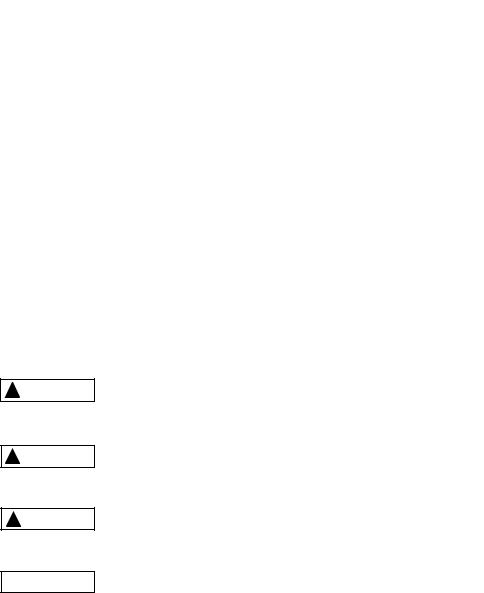
|
Safety Precautions |
|
|
! |
|
|
|
|
|
|
|
For your safety, read this manual thoroughly before operating your Scan Tool. Always refer to and follow safety messages and test procedures provided by the manufacturer of the vehicle or equipment being tested.
The safety messages presented below and throughout this user’s manual are reminders to the operator to exercise extreme care when using this test instrument.
Read All Instructions
Read, understand and follow all safety messages and instructions in this manual and on the test equipment. Safety messages in this section of the manual contain a signal word with a three-part message and, in some instances, an icon.
Safety Messages
Safety messages are provided to help prevent personal injury and equipment damage. All safety messages are introduced by a signal word. The signal word indicates the level of the hazard in a situation. The types of safety messages are.
!DANGER
!WARNING
!CAUTION
IMPORTANT
Indicates a possible hazardous situation which, if not avoided, will result in death or serious injury to operator or bystanders.
Indicates a possible hazardous situation which, if not avoided, could result in death or serious injury to operator or bystanders.
Indicates a possible hazardous situation which, if not avoided, may result in moderate or minor injury to operator or bystanders.
Indicates a condition which, if not avoided, may result in damage to test equipment or vehicle.
• • • • • • • • • • • • • • • • • • • • • • • • • • • • • • • • • • • • • • • • • • • • • • • • • • • • • • Safety – i
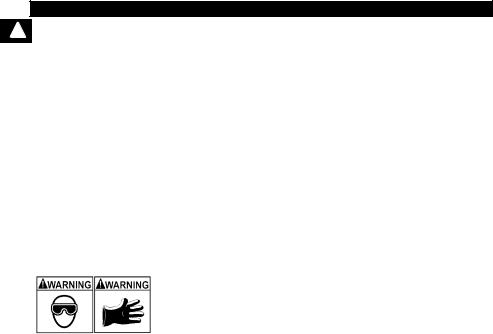
|
Safety Precautions |
! |
Type Styles Used: |
Safety messages contain three different type styles.
•Normal type states the hazard.
•Bold type states how to avoid the hazard.
•Italic type states the possible consequences of not avoiding the hazard.
Icons used:
An icon, when present, gives a graphical description of a potential hazard.
Example:
Engine systems can malfunction expelling fuel, oil vapors, hot steam, hot toxic exhaust gases, acid, refrigerant and other debris.
Safety goggles and protective gloves must be worn by the operator and any bystanders. Even if everyday eyeglasses have impact resistant lenses, they are NOT safety glasses.
Engine systems that malfunction can cause injury.
Safety – ii • • • • • • • • • • • • • • • • • • • • • • • • • • • • • • • • • • • • • • • • • • • • • • • • • • • • •
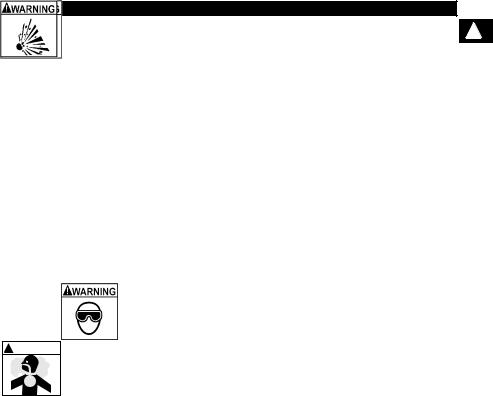
Safety Precautions |
|
Important Safety Messages |
! |
Risk of electric shock.
•Do not exceed voltage limits between inputs indicated in the Specifications.
•Use extreme caution when working with circuits that have voltage greater than 60 volts DC or 24 volts AC.
Electric shock can cause injury.
! WARNING |
Risk of explosion.
•Safety goggles and protective clothing must be worn by the operator and any bystanders.
-Even if everyday glasses have impact resistant lenses, they are NOT safety glasses, and may not provide adequate protection.
•Do not use this scan tool in environments where explosive vapors may collect. These areas include:
-below-ground pits.
-confined areas.
-areas that are less than 18 inches above floor.
•Use this Scan Tool in locations with mechanical ventilation providing at least 4 air changes per hour.
•Flammable fuel and vapors can ignite.
•Do not smoke, strike a match, or cause a spark in the vicinity of the battery. Battery gases can ignite.
• • • • • • • • • • • • • • • • • • • • • • • • • • • • • • • • • • • • • • • • • • • • • • • • • • • • • Safety – iii
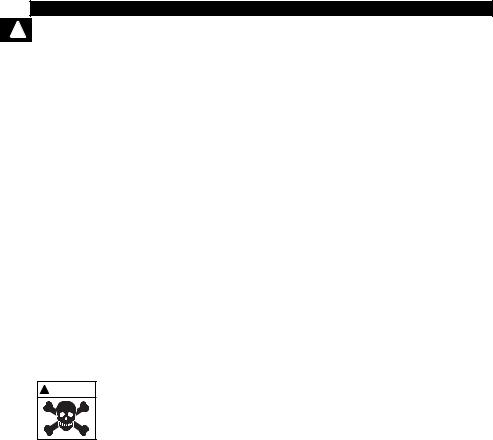
Safety Precautions
! |
• Avoid making an accidental connection between the |
|
battery terminals. Do not place uninsulated metal |
|
tools on the battery. |
|
• When removing battery cables, remove the ground |
|
cable first. |
|
• Avoid sparks when connecting or disconnecting |
|
power leads to the battery. |
|
• Make sure ignition is off, headlights and other |
|
accessories are off and vehicle doors are closed |
|
before disconnecting the battery cables. |
|
- This also helps prevent damage to on-board computer sys- |
|
tems. |
|
• Always disconnect the battery ground connections |
|
before servicing electrical system components. |
Explosion can cause injury.
! WARNING |
Risk of poisoning.
•Use this Scan Tool in locations with mechanical ventilation providing at least 4 air changes per hour. Engine exhaust contains odorless gas which can be lethal.
•Route the exhaust outside while testing with the engine running.
Poisoning can result in death or serious injury.
Safety – iv • • • • • • • • • • • • • • • • • • • • • • • • • • • • • • • • • • • • • • • • • • • • • • • • • • • •

Safety Precautions
! WARNING |
Battery acid is a highly corrosive sulfuric acid. |
! |
|
|
•Safety goggles and protective gloves must be worn by the operator and any bystanders.
-Even if your everyday glasses have impact resistant lenses, they are NOT safety glasses, and may not provide adequate protection.
•Make sure someone can hear you or is close enough to provide aid when working near a battery.
•Have plenty of fresh water and soap nearby.
-If battery acid contacts skin, clothing, or eyes, flush exposed area with soap and water for 10 minutes. Seek medical help.
•Do not touch eyes while working near battery.
Battery acid can burn eyes and skin.
• • • • • • • • • • • • • • • • • • • • • • • • • • • • • • • • • • • • • • • • • • • • • • • • • • • • • Safety – v
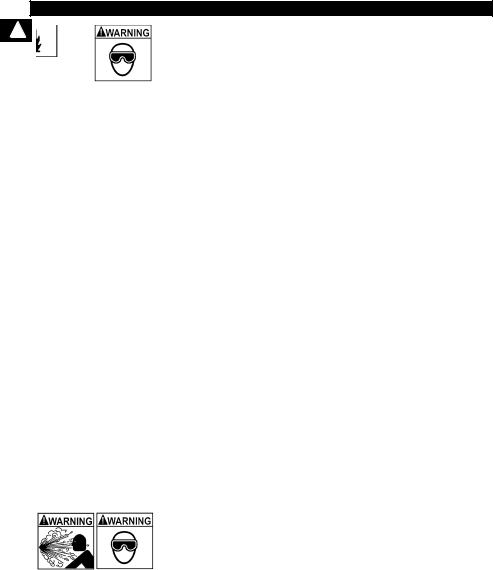
|
Safety Precautions |
! |
Risk of fire. |
•Safety goggles and protective clothing must be worn by the operator and any bystanders.
-Even if your everyday glasses have impact resistant lenses, they are NOT safety glasses, and may not provide adequate protection.
•Do not position your head directly in front of or over the throttle body.
•Do not pour gasoline down the throttle body when cranking or running the engine, when working with fuel delivery systems or any open fuel line.
- Engine backfire can occur when the air cleaner is out of position.
•Do not use fuel injector cleaning solvents when performing diagnostic testing.
•Keep cigarettes, sparks, open flame and other sources of ignition away from vehicle.
•Keep a dry chemical (Class B) fire extinguisher rated for gasoline, chemical and electrical fires in work area.
Fire can cause death or serious injury.
Risk of flying particles.
•Safety goggles and protective gloves must be worn by the operator and any bystanders while using electrical equipment.
-Electrical equipment or rotating engine parts can cause flying particles.
-Even if your everyday glasses have impact resistant lenses, they are NOT safety glasses, and may not provide adequate protection.
Flying particles can cause eye injury.
Safety – vi • • • • • • • • • • • • • • • • • • • • • • • • • • • • • • • • • • • • • • • • • • • • • • • • • • • •
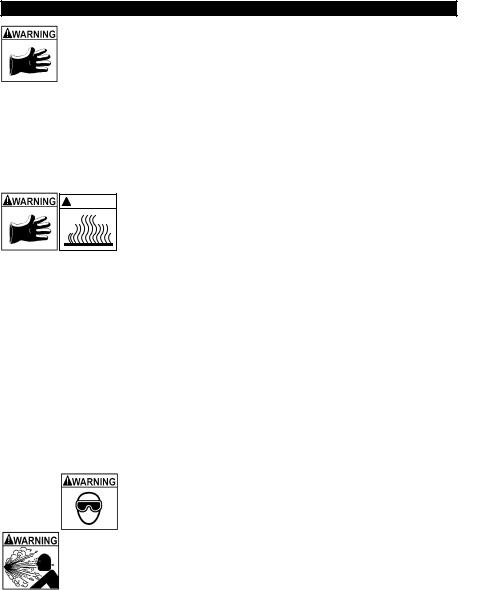
Safety Precautions
Risk of burns. |
! |
|
|
•Batteries can produce a short-circuit current high enough to weld jewelry to metal.
-Remove jewelry such as rings, bracelets and watches before working near batteries.
Short circuits can cause injury.
! WARNING |
Risk of burns.
•Do not remove radiator cap unless engine is cold.
- Pressurized engine coolant may be hot.
•Do not touch hot exhaust systems, manifolds, engines, radiators, sample probe.
•Wear insulated gloves when handling hot engine components.
•Tester leads can become hot after extended testing in close proximity to manifolds.
Hot components can cause injury.
Risk of expelling fuel, oil vapors, hot steam, hot toxic exhaust gases, acid, refrigerant and other debris.
•Safety goggles and protective clothing must be worn by the operator and any bystanders.
-Even if your everyday glasses have impact resistant lenses, they are NOT safety glasses, and may not provide adequate protection.
•Engine systems can malfunction, expelling fuel, oil vapors, hot steam, hot toxic exhaust gases, acid, refrigerant and other debris.
Fuel, oil vapors, hot steam, hot toxic exhaust gases, acid, refrigerant and other debris can cause serious injury.
• • • • • • • • • • • • • • • • • • • • • • • • • • • • • • • • • • • • • • • • • • • • • • • • • • • • Safety – vii

|
Safety Precautions |
! |
Engine compartment contains electrical connections and |
|
hot or moving parts. |
•Keep yourself, test leads, clothing and other objects clear of electrical connections and hot or moving engine parts.
•Do not wear watches, rings, or loose fitting clothing when working in an engine compartment.
•Do not place tools or test equipment on fenders or other places in engine compartment.
•Barriers are recommended to help identify danger zones in test area.
•Prevent personnel from walking through test area.
Contacting electrical connections and hot or moving parts can cause injury.
Risk of injury.
•The Scan Tool should be operated by qualified personnel only.
•Use the scan tool only as described in the user’s manual.
•Use only manufacturer’s recommended attachments.
•Do not operate the Scan Tool with damaged cables.
•Do not operate the Scan Tool if it has been dropped or damaged, until examined by a qualified service representative.
Operation of the Scan Tool by anyone other than qualified personnel may result in injury.
Safety – viii• • • • • • • • • • • • • • • • • • • • • • • • • • • • • • • • • • • • • • • • • • • • • • • • • • • •
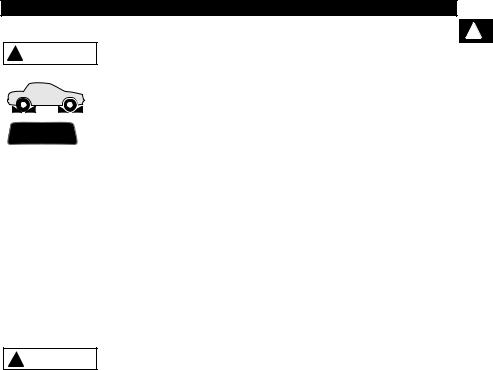
Safety Precautions
!
! WARNING |
Risk of unexpected vehicle movement. |
|
• Block drive wheels before performing a test with engine running.
PRNDL2
! CAUTION
•Unless instructed otherwise:
-set parking brake
-put gear selector in neutral for manual transmissions
-put gear selector in park for automatic transmissions
-disconnect release mechanism on the automatic parking brake release for testing and reconnect when testing is completed.
• Do not leave a running engine unattended.
A moving vehicle can cause injury.
Risk of equipment or circuit damage.
•Unless specifically directed by manufacturer, make sure ignition is off before connecting or disconnecting connectors or any vehicle electrical terminals.
•Do not create a short between battery terminals with a jumper wire or tools.
Improper equipment use can cause equipment or circuit damage.
• • • • • • • • • • • • • • • • • • • • • • • • • • • • • • • • • • • • • • • • • • • • • • • • • • • • • Safety – ix

Safety Precautions
! |
! CAUTION |
|
Misdiagnosis may lead to incorrect or improper repair and/or adjustment.
•Do not rely on erratic, questionable, or obviously erroneous test information or results.
-If test information or results are erratic, questionable, or obviously erroneous, make sure all connections and data entry information are correct and test procedures were performed correctly.
-If test information or results are still suspicious, do not use them for diagnosis.
Improper repair and/or adjustment may cause vehicle or equipment damage or unsafe operation.
! DANGER |
Some vehicles are equipped with air bags. |
|
•Follow service manual warnings when working around air bag components or wiring.
-If service manual instructions are not followed, an air bag may deploy unexpectedly, resulting in injury.
-Note an air bag can still deploy several minutes after ignition key is off (or even if vehicle battery is disconnected) because of a special energy reserve module.
An air bag opening can cause injury.
Safety – x • • • • • • • • • • • • • • • • • • • • • • • • • • • • • • • • • • • • • • • • • • • • • • • • • • • • •

Section 1 – Using This Manual
This manual contains instructions for the use and setup of your Scan Tool. A table of contents and glossary are provided to make this manual easy to use.
Some of the information shown in text or illustrations is obtained using optional |
|
equipment. A Sales Representative can determine option availability. |
1 |
This section contains a list of conventions used. |
Safety Messages
Refer to Safety Precautions on page Safety - i.
Check Note
A check note provides additional information about the subject in the preceding paragraph.
Example:
English is the default measurement unit.
Equipment Tips and Lists
Equipment tips and lists provide information that applies to specific equipment. Each tip is introduced by this icon r for easy identification.
Example:
Observe all vehicle and/or equipment manufacturer’s cautions and warnings when testing with the Scan Tool.
Equipment Damage
Situations arise during testing that could damage the vehicle or the test equipment. The word IMPORTANT signals these situations.
Example:
IMPORTANT Failure to follow these instructions could damage the Scan Tool.
• • • • • • • • • • • • • • • • • • • • • • • • • • • • • • • • • • • • • • • • • • • • • • • • • • • • • • • • • 1 – 1

Using This Manual
Functions and Selections
Diagnostic and tool functions performed by the Scan Tool are highlighted in bold.
Example:
The View Data function allows you to view the vehicle’s parameter identification (PID) data in real time.
1
Menus
The menus on the Scan Tool display are referenced in the procedures and are highlighted in bold-italic text.
Example:
When the OBDII Function List menu displays, the Scan Tool is ready for use.
Questions and Responses
Messages and user responses are CAPITALIZED.
Example:
The Scan Tool displays the pending DTCs or a message stating SYSTEM PASS: NO FAULT DETECTED.
Manual References
Used to reference other sections of the manual. References include the Title and page number (section-page).
Example:
For more information on DTCs, refer to “OBD II Diagnostic Trouble Codes (DTCs)” on page 2-15
Screens
Certain help messages, information, and data that are displayed on the scan tool are also shown in graphical text boxes. The screens are presented as examples and may change as the software is updated.
Example:
Main Menu
Global OBD II
Domestic Vehicles
European Vehicles
Asian Vehicles
Review Data
Print Data
System Setup
1 – 2 • • • • • • • • • • • • • • • • • • • • • • • • • • • • • • • • • • • • • • • • • • • • • • • • • • • • • • • •

Section 2 – Getting Started
Introduction
The Scan Tool was developed by experts in the automotive service industry to help diagnose vehicles and assist in troubleshooting procedures.
The Scan Tool monitors vehicle events and retrieves codes from the |
2 |
vehicle’s control modules to help pinpoint problem areas.
All information, illustrations and specifications contained in this manual are based on the latest information available from industry sources at the time of publication.
No warranty (expressed or implied) can be made for its accuracy or completeness, nor is any responsibility assumed by the manufacturer or anyone connected with it for loss or damages suffered through reliance on any information contained in this manual or misuse of
• • • • • • • • • • • • • • • • • • • • • • • • • • • • • • • • • • • • • • • • • • • • • • • • • • • • • • • • • 2 – 1

Getting Started
accompanying product. The manufacturer reserves the right to make changes at any time to this manual or accompanying product without obligation to notify any person or organization of such changes.
Using the CD
The included CD is NOT required to operate the Scan Tool
Install the CD application prior to connecting the Scan Tool to the PC.
2Some of the items included on the CD are:
Manuals included with Scan Tool
DTC lookup software
Scan Tool update software
Adobe Acrobat Reader Installer
Print Capture
Other product information
To be able to use the included CD the PC must meet the following minimum requirements:
486 PC
4 MB of RAM
Microsoft Windows 98 SE, ME, 2000, and XP
CD ROM Drive
Adobe Acrobat Reader
2 – 2 • • • • • • • • • • • • • • • • • • • • • • • • • • • • • • • • • • • • • • • • • • • • • • • • • • • • • • • •
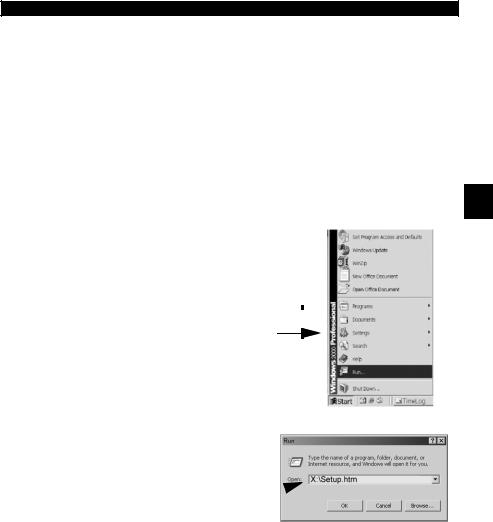
Getting Started
Internet Explorer 4.0 or newer
Screen Resolution of 800 x 600
–If screen resolution is 800 x 600, in Display Properties, Settings Tab, set Font Size to Small Fonts.
Installing Applications On Included CD
1.Close all programs on the computer.
2.Place the CD in CD-Drive.
2
If CD does not start automatically;
Select the Start button.
Select Run...
Enter “X:\Setup.htm” in Open Box on Computer and select OK. Run 
Start
“X” is the CD-ROM drive letter on the computer.
Enter 
3.Follow screen prompts on the computer to install the applications.
• • • • • • • • • • • • • • • • • • • • • • • • • • • • • • • • • • • • • • • • • • • • • • • • • • • • • • • • • 2 – 3

Getting Started
Vehicle Service Information
The following is a list of web sites and phone numbers where electronic engine control (EEC) diagnostic information is available.
Some manuals may be available at your local dealer, auto parts stores or local public libraries.
|
Domestic Vehicles |
Web Site |
Phone Number |
|
General Motors |
|
|
2 |
|
|
|
Chevrolet |
www.chevrolet.com |
1-800-551-4123 |
|
|
Pontiac |
www.pontiac.com |
1-800-551-4123 |
|
Oldsmobile |
www.oldsmobile.com |
1-800-551-4123 |
|
Buick |
www.buick.com |
1-800-551-4123 |
|
Cadillac |
www.cadillac.com |
1-800-333-4CAD |
|
Saturn |
www.saturn.com |
1-800-553-6000 |
|
Ford |
www.ford.com |
1-800-392-3673 |
|
Ford |
||
|
Lincoln |
www.lincoln.com |
1-800-392-3673 |
|
Mercury |
www.mercury.com |
1-800-392-3673 |
|
Chrysler |
www.chrysler.com |
1-800-348-4696 |
|
Chrysler |
||
|
Dodge |
www.dodge.com |
1-800-348-4696 |
|
Plymouth |
Not Available |
1-800-348-4696 |
|
Eagle |
Not Available |
1-800-348-4696 |
European Vehicles
Audi |
www.audi.com |
1-800-544-8021 |
Volkswagon |
www.vw.com |
1-800-544-8021 |
BMW |
www.bmw.com |
1-201-307-4000 |
MINI |
www.mini.com |
1-201-307-4000 |
Jaguar |
www.jaguar.com |
1-800-4-JAGUAR |
Volvo |
www.volvo.com |
1-800-458-1552 |
Mercedes-Benz |
www.mercedes-benz.com |
1-800-367-6372 |
Land Rover |
www.landrover.com |
1-800-637-6837 |
Porsche |
www.porsche.com |
1-800-PORSCHE |
Saab |
www.saab.com |
1-800-955-9007 |
Asian Vehicles |
Web Site |
Phone Number |
Acura |
www.acura.com |
1-800-999-1009 |
Honda |
www.honda.com |
1-800-999-1009 |
Lexus |
www.lexus.com |
1-800-255-3987 |
Scion |
www.scion.com |
1.866.70.SCION |
Toyota |
www.toyota.com |
1-800-GO-TOYOTA |
2 – 4 • • • • • • • • • • • • • • • • • • • • • • • • • • • • • • • • • • • • • • • • • • • • • • • • • • • • • • • •

Getting Started
Hyundai |
www.hyundai.com |
1-800-633-5151 |
Infiniti |
www.infiniti.com |
1-800-662-6200 |
Nissan |
www.nissanusa.com |
1-800-nissan1 |
Kia |
www.kia.com |
1-800-333-4542 |
Mazda |
www.mazda.com |
1-800-222-5500 |
Daewoo |
www.daewoo.com |
1-822-759-2114 |
Subaru |
www.subaru.com |
1-800-SUBARU3 |
Isuzu |
www.isuzu.com |
1-800-255-6727 |
Geo |
Not Available |
Not Available |
Mitsubishi |
www.mitsubishi.com |
1-888-MITSU2004 |
Suzuki |
www.suzukiauto.com |
1-800-934-0934 |
Other Manuals |
|
|
2 |
Chilton Book Company |
www.chiltonsonline.com |
1-800-347-7707 |
|
|
|||
Haynes Publications |
www.haynes.com |
1-800-242-4637 |
|
Bentley Publishers |
www.bentleypublishers.com |
1-800-423-4595 |
|
Repair Information Programs |
|
|
|
Mitchell |
www.mitchell1.com |
1-888-724-6742 |
|
ALLDATA |
www.alldata.com |
1-800-697-2533 |
|
Suitable Manual Titles |
|
|
|
Diagnostic Service Manuals |
|
|
|
PowerTrain Codes and Oxygen Sensors Automotive Emission Control Manual Fuel Injection
Automotive Electrical Manual Automotive Electrics and Electronics Automotive Sensors
Electronic Transmission Control Emission Control Technology Engine Management
or similar titles...
• • • • • • • • • • • • • • • • • • • • • • • • • • • • • • • • • • • • • • • • • • • • • • • • • • • • • • • • • 2 – 5

Getting Started
Introduction to On-Board Diagnostics
OBD I
The original on-board diagnostics (OBD I) lacked consistency in communication and interface while allowing different interpretations among vehicle manufacturers. Ford and Chrysler used different types of engine control computers and data link connectors ( DLCs), and GM varied the trouble codes and communication protocols from year-to-year.
OBD II
2
On-board diagnostics version II (OBD II) is a system that the Society of Automotive Engineers (SAE) developed to standardize automotive electronic diagnosis.
Beginning in 1996, most new vehicles sold in the United States were fully OBD II compliant.
Technicians can now use the same tool to test any OBD II compliant vehicle without special adapters. SAE established guidelines that provide:
A universal connector, called the DLC, with dedicated pin assignments.
A standard location for the DLC, visible under the dash on driver’s side.
A standard list of diagnostic trouble codes (DTCs) used by all manufacturers.
A standard list of parameter identification (PID) data used by all manufacturers.
Ability for vehicle systems to record operating conditions when a fault occurs.
Expanded diagnostic capabilities that records a code whenever a condition occurs that affects vehicle emissions.
Ability to clear stored codes from the vehicle’s memory with a Scan Tool.
2 – 6 • • • • • • • • • • • • • • • • • • • • • • • • • • • • • • • • • • • • • • • • • • • • • • • • • • • • • • • •

Getting Started
SAE Publications
SAE has published hundreds of pages of text defining a standard communication protocol that establishes hardware, software, and circuit parameters of OBD II systems. Unfortunately, vehicle manufacturers have different interpretations of this standard communications protocol. As a result, the generic OBD II communications scheme varies, depending on the vehicle. SAE publishes recommendations, not laws, but the Environmental Protection Agency (EPA) and California Air Resources Board (CARB) made many of SAE’s recommendations legal requirements that vehicle
manufacturers were required to phase in over a three-year period. 2 Beginning in 1994, vehicles with a new engine management computer
( about 10% of each manufacturers fleet ) were supposed to comply with OBD II standards. For 1995, OBD II systems were to appear on about 40% of the new vehicles sold in the United States. Some of the 1994-1995 OBD II systems were not fully compliant, so the Government granted waivers to give manufacturers time to fine-tune their systems. Beginning in 1996, most of the new vehicles sold in the United States were fully OBD II compliant.
The tables below highlight changes for GM, Ford, and Chrysler. If this seems confusing, don’t worry. The Scan Tool makes it easy. Based on the vehicle identification (VIN) information selected during Scan Tool setup, the vehicle is automatically recognized. All you have to do is choose the correct adapter cable and jumper wires (if necessary). Details on adapter cables and jumper wires may be found in Data LInk Connector on page 2-9.
GM On-Board Diagnostics
System |
Years |
Description |
|
|
Most vehicles used the 12-pin ALDL (Assembly Line Data Link) |
OBD I Control Module |
1981–1995 |
located under the dash on the driver side. Some 94-95 vehicles |
used the 16-pin OBD II (J1962) data link connector (DLC), but |
||
|
|
use the Historical application software. Refer to the vehicle’s |
|
|
Vehicle Emission Control Information label. |
OBD II Control Module |
1994*-Present |
Complies with OBD II regulations and uses the J1962 DLC. |
* OBD II system is used on certain 1994-1995 vehicles equipped with a 2.2L, 2.3L, 3.8L, 4.3L or 5.7L engines.
• • • • • • • • • • • • • • • • • • • • • • • • • • • • • • • • • • • • • • • • • • • • • • • • • • • • • • • • • 2 – 7

Getting Started
Ford On-Board Diagnostics
|
|
System |
Long Name |
|
|
|
Years |
|
Description |
|
|
|
MCU |
Microprocessor Control Unit |
|
1980 –1991 |
|
Used in police vehicles, containing carbureted |
|||
|
|
|
|
engines. Uses the MCU DLC. |
||||||
|
|
|
|
|
|
|
|
|
|
|
|
|
EEC-IV |
Electronic Engine Control, |
|
1984 –1995 |
|
Most Ford vehicles equipped with North |
|||
|
|
Fourth generation |
|
|
|
|
American engines. Uses the EEC-IV DLC. |
|||
|
|
MECS |
Mazda Electronic Control |
|
1988 –1995 |
|
Vehicles equipped with Mazda-sourced engines. |
|||
|
|
System |
|
|
|
|
Uses MECS 6-pin and 17-pin DLCs. |
|||
|
|
EEC-V |
Electronic Engine Control, |
|
1994* – present |
|
Complies with OBD II regulations and uses the |
|||
|
|
Fifth generation |
|
|
|
|
OBD II J1962 DLC. |
|||
|
|
PTEC |
Powertrain Electronic |
|
|
|
2000 – present |
|
Complies with OBD II regulations and uses the |
|
2 |
|
Controller |
|
|
|
|
OBD II J1962 DLC. |
|||
|
* EEC-V OBD II system used in 1994-1995 vehicles equipped with a 3.8L or 4.6L engine. |
|||||||||
|
|
|
|
Chrysler On-Board Diagnostics |
||||||
|
|
System |
Long Name |
|
|
Years |
|
|
Description |
|
|
|
SMEC |
Single Module Engine |
1989–1990 |
Used a 6-pin Serial Communication Interface (SCI) |
|||||
|
|
Controller |
|
DLC and has bidirectional capability. |
||||||
|
|
SBEC |
Single Board Engine |
|
|
|
|
Used two types of DLCs: a 6-pin SCI and a 6-pin LH |
||
|
|
|
1989*–1995 |
series. |
|
|||||
|
|
Controller |
|
|
||||||
|
|
|
|
|
|
|
The first to allow a tool to reset the EMR light on trucks. |
|||
|
|
|
|
|
|
|
|
|||
|
|
OBD II |
OBD II Powertrain |
|
1995**– present |
Complies with OBD II regulations and uses the OBD II |
||||
|
|
PCM |
Control Module |
|
|
|
|
J1962 DLC. |
||
|
|
|
Jeep/Truck Engine |
|
|
|
|
Complies with OBD II regulations and uses the OBD II |
||
|
|
JTEC |
|
1996– present |
J1962 DLC. |
|||||
|
|
Controller |
|
The JTEC system is used on light-duty trucks and |
||||||
|
|
|
|
|
|
|
||||
|
|
|
|
|
|
|
|
Jeeps |
|
|
*In 1989, the SBEC system was installed in selected vehicles with 3.0L V6 engines.
**Some vehicles in 1995 were equipped with the OBD II PCM.
2 – 8 • • • • • • • • • • • • • • • • • • • • • • • • • • • • • • • • • • • • • • • • • • • • • • • • • • • • • • • •
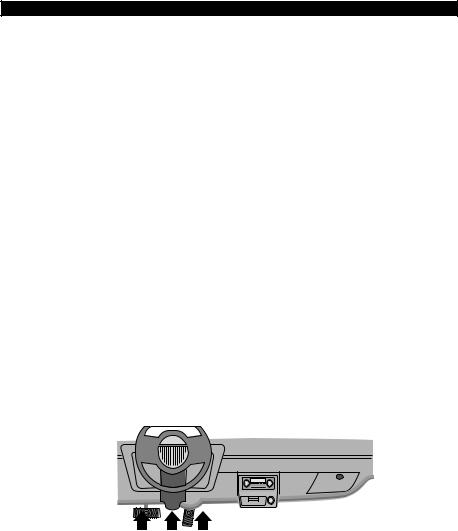
Getting Started
Data Link Connector (DLC)
The data link connector (DLC) allows the Scan Tool to communicate with the vehicle’s computer(s). Before OBD II, manufacturers used different DLC’s to communicate with the vehicle. use the proper DLC adapter cable to connect the Scan Tool to the vehicle. Also, the vehicle’s DLC may be found in several different places and have many different configurations. The following describes the DLCs used by Ford, GM and Chrysler. The DLC location and types for domestic vehicles can be looked up in the charts in Appendix B - Data Link Connectors.
OBD II (J1962) |
2 |
Beginning in 1996, vehicles sold in the United States use the J1962 (OBD II) DLC, a term taken from a physical and electrical specification number assigned by the SAE (J1962). The DLC should be located under the dashboard on the driver’s side of the vehicle. If the DLC is not located under the dashboard as stated, a decal describing its location should be attached to the dashboard in the area the DLC should have been located.
Because the OBD II J1962 connector has power and ground, you only need a single cable connection to the tool for both power and tool communications. Attach the OBD II adapter cable to the extender cable, (both supplied with the tool) to connect the tool. Certain pins in the connector are reserved.
.
• • • • • • • • • • • • • • • • • • • • • • • • • • • • • • • • • • • • • • • • • • • • • • • • • • • • • • • • • 2 – 9
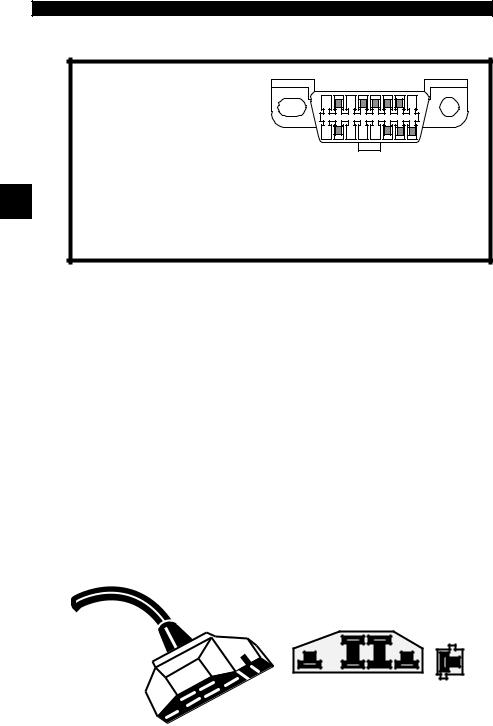
Getting Started
Data Link Connector (DLC) Pins
1 |
- Manufacturer Reserved |
1 |
8 |
|
|
|
|||
2 |
- J1850 Bus+ |
|
|
|
3 |
- Manufacturer Reserved |
|
|
|
4 |
- Chassis Ground |
|
|
|
5 |
- Signal Ground |
9 |
16 |
|
6 |
- CAN High, J-2284 |
|||
|
|
7- K Line, ISO 9141-2 & ISO/DIS 14230-4
8- Manufacturer Reserved
2 |
9 - Manufacturer Reserved |
13 |
- Manufacturer Reserved |
|
|
10 |
- J1850 Bus- |
14 |
- CAN Low, J-2284 |
|
11 |
- Manufacturer Reserved |
15 |
- L Line, ISO 9141-2 & ISO/DIS 14230-4 |
|
12 |
- Manufacturer Reserved |
16 |
- Battery Power |
Ford Historic
Ford used three types of DLCs with their OBD I systems. Refer to
Appendix B - Data Link Connectors for the adapter cable needed for your vehicle.
IMPORTANT |
Use the cigarette lighter cable to provide power to the |
|
Scan Tool for all systems. |
|
EEC-IV/MCU
The EEC-IV/MCU DLC is a large six-sided connector with a pigtail connector. The pigtail connector is not used on MCU vehicles – leave the pigtail unattached. The EEC-IV/MCU cable adapter is included with the Scan Tool.
Cable Adapter |
Vehicle DLC |
EEC-IV/MCU |
EEC-IV/MCU |
To Scan |
STI Pigtail |
Tool |
EEC-IV only |
2 – 10 • • • • • • • • • • • • • • • • • • • • • • • • • • • • • • • • • • • • • • • • • • • • • • • • • • • • • • •
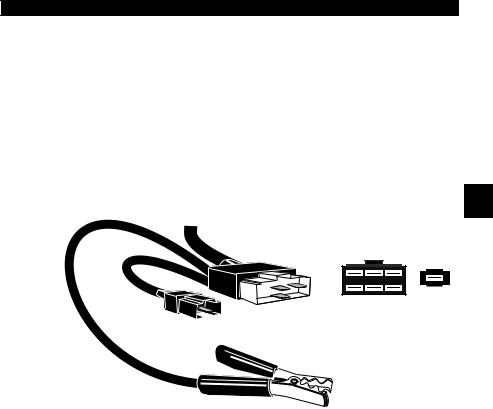
Getting Started
MECS
MECS vehicles (1988 –1995) use either a 6-pin (with pigtail) or a 17-pin DLC. Use the MECS 6-pin adapter cable kit (CP9131) for both configurations. The MECS adapter cable kit includes jumper wires to connect to the MECS 17-pin DLC. The MECS adapter cable kit is optional and must be purchased separately. Use the following diagrams to connect the adapter cable.
6-Pin MECS
Cable Adapter |
|
Vehicle DLC |
6-Pin MECS |
|
6-Pin MECS |
P/N CP9131 |
|
2 |
|
|
|
To Scan |
|
|
Tool |
|
|
|
|
Pigtail |
4 |
5 |
6 |
3 |
||
1 |
2 |
|
|
|
STI Pigtail
Clip to good vehicle ground
• • • • • • • • • • • • • • • • • • • • • • • • • • • • • • • • • • • • • • • • • • • • • • • • • • • • • • • • 2 – 11
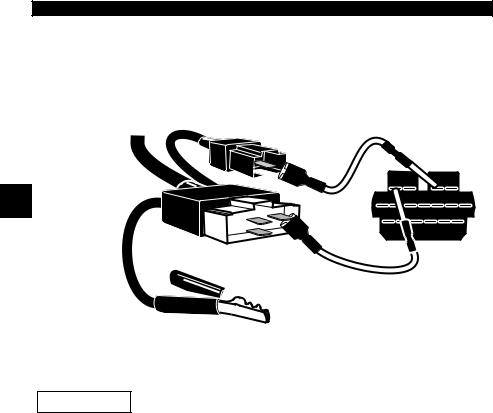
2
Getting Started
17-Pin MECS
Adapter Cable |
Vehicle DLC |
6-Pin MECS |
17-Pin MECS |
P/N CP9131 |
|
To |
|
Scan Tool |
|
STI Pigtail |
|
4 |
5 |
6 |
|
3 |
|||
2 |
|||
1 |
|||
|
|||
|
|
STO


 Clip to good vehicle ground
Clip to good vehicle ground
MECS Ford Probe
Certain Ford Probes have a WHITE TACH IMPORTANT CONNECTOR located very close to the 6-pin
self-test connector and bundled in the same wiring harness. This is not the self-test input (STI) pigtail.
Connect the pigtail to the BLACK STI connector located farther back on the wire harness. If the tool is connected to the WHITE tach connector, serious damage may result and may void warranty. Refer to the illustration.
2 – 12 • • • • • • • • • • • • • • • • • • • • • • • • • • • • • • • • • • • • • • • • • • • • • • • • • • • • • • •
